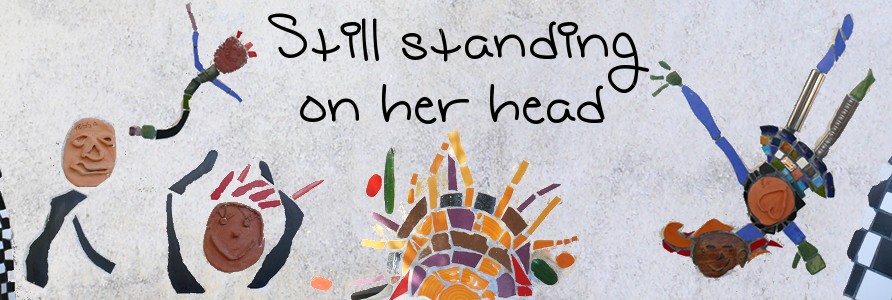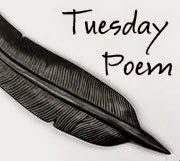I won't bore my readers with the details of what I found, except to say that I was surprised and delighted to find a photo of my greatgrandfather in a private deposit - the genealogical research of a person who is probably (not proven) a distant cousin. By the end of the morning, I felt that we had gathered most that was of value, and though there were things we could look at if we went back, it wasn't the best use of time, so I cancelled the booking for the next day.
We then went to meet my cousins (fourth cousins, actually), as they were to take us to visit the family farm. Though it was sold off by my Scottish relations around 1960, they are still in contact with the current owners. First we headed to St Ninians churchyard. St Ninians is now a suburb of Stirling but was once a separate village. R and N had tried to get the key to the churchyard, but the council has stopped giving it out, due to a dangerous section of wall inside the graveyard. So we climbed over the outer wall instead. The "dangerous" wall was well-roped off and we didn't feel in any danger at all.
The photo is of the old church tower. In 1745 the Jacobites stored their gunpowder in St Ninians church, and it blew up, leaving only the tower standing. A new church was built nearby.

We visited the current owner of the farm, who lives at a different farm nearby, then headed to the farm where my greatgreatgrandfather was born in 1802. The current owner's son lives there, but he wasn't in evidence, so we looked around the outside only. From information in old wills and censuses (Scottish censuses used to state how many rooms with windows each house had) we figured that the current house was probably not the one that existed in the early 1800s. That house is now being used as an outhouse, if my guess is correct, and here are the current residents:

An overall view of the ducks' accommodation - which once housed a family with seven children:

This view is looking over towards the Firth of Forth from the farm:

We photographed family gravestones in another local cemetery and had an enjoyable afternoon tea at a nearby garden centre before parting ways with R and N (not before accepting an invitation from R to stay with him and his wife in Perth later in our trip).
On the way back in the evening we took another detour as I wanted to see the farm where my greatgrandmother lived as a girl. I didn't have any local contacts for this one, but I did have an Ordnance Survey map with farm names on. So, I decided just to head up to the farm and knock. This is the farmhouse (my greatgrandparents were married here):

It appears to have been added to since the mid 1800s, when it had five rooms, which was large by the standards of the day - but crowded by modern standards given that there were two parents, one daughter and four sons, a mother, a father-in-law and several farm servants living there (though perhaps the young male servants bedded down in the loft).
The farm was closer to Stirling than I realised and had a wonderful view across the river and the surrounding level fields, to Stirling castle:

The next day, instead of going to the archives I headed for the Central Scotland Family History Project which is situated at Cowane's Hospital. This was built in the 1600s as an almshouse for poor members of the merchant guild. The statue of John Cowane, known as Old Staneybreeks, supposedly comes down to dance in the courtyard when midnight strikes on New Years' Eve.


The Family History offices were not yet open so we looked around the area, and especially the Church of the Holy Rude, a church steeped in history. King James VI was crowned here, so it is the only active church in Britain apart from Westminster Abbey to have witnessed a coronation. I wasn't able to get as much information as I'd hoped from the family history project, though the person who runs it has been very helpful answering my questions by e-mail in the past. He was able to show me from burial records where in the churchyard some of my ancestors were buried - unfortunately the gravestone was made of very soft stone, and the inscription has totally worn away.
We then headed off to Callendar House in Falkirk.

There is a substantial collection of local history archives here including the papers of another relative of mine, and again I was able to find documents of interest (and a much more generous policy regarding charges for copying!). We toured the museum here, then headed outside to take more photos of squirrels:

and look at the section of the Antonine wall that crosses the large estate.
Then it was off to see the Falkirk Wheel - a spectacular rotating boat lift connecting the Union Canal with the Forth and Clyde canal. It used to take a day's journey through a series of nearly a dozen locks to get from one to the other. They had fallen into disuse and been filled in. The cost to restore the locks would have been prohibitive, so this was the ingenious alternative.
We didn't take a boat tour through the wheel, but we did arrive in time to watch it in action, probably on the last boat ride for the day.

A view of the Union Canal:

And then we headed back through Stirling and the countryside that was rapidly becoming familiar, to Loch Ard, our base for the week - through the small village of Thornhill

and heading west through towards sunset:




No comments:
Post a Comment